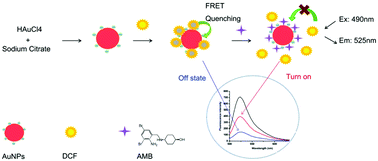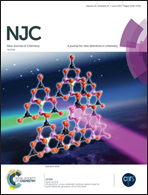A turn-on FRET sensor based on dichlorofluorescein and AuNPs for rapid and ultrasensitive detection of ambroxol hydrochloride in urine†‡
Abstract
A novel turn-on fluorescence sensor is proposed for the ultra-sensitive detection of ambroxol hydrochloride in urine based on the high fluorescence quenching ability of gold nanoparticles toward dichlorofluorescein. Fluorescence intensity was significantly quenched by fluorescence resonance energy transfer when dichlorofluorescein molecules were attached to the surface of gold nanoparticles (AuNPs) by electrostatic interactions. Upon addition of ambroxol hydrochloride, the fluorescence intensity was turned on due to competitive adsorption between ambroxol hydrochloride and dichlorofluorescein to the AuNP surfaces. At optimum pH, AuNP concentration, incubation time, and reaction temperature, the fluorescence recovery efficiency [(F − F0)/F0] at 525 nm showed a good linear relationship (R2 = 0.9953) from 5.0 × 10−9 to 10−7 M, with a low detection limit of 3.6 × 10−9 M, with ambroxol hydrochloride. The developed method had several advantages, such as high sensitivity and selectivity, short analysis time, low cost, and ease of operation. The proposed method has been successfully applied to determine ambroxol hydrochloride in water and human urine samples and may provide outstanding application potential in the future development of sensors for clinical monitoring of ambroxol hydrochloride.



 Please wait while we load your content...
Please wait while we load your content...